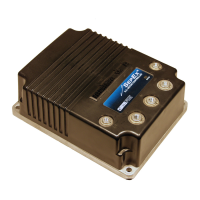A-8
Curtis 1244 Manual, Rev. E
APPENDIX A: GLOSSARY
PWM
Pulse width modulation (PWM), also called “chopping,” is a technique that
switches battery voltage to the motor on and o very quickly, thereby con-
trolling the speed of the motor. Curtis 1200 series controllers use high frequency
PWM—in this case, 16 kHz—which permits silent, efficient operation.
Quick-start
Upon receiving a quick throttle demand from neutral, the controller will
momentarily exceed normal acceleration in order to overcome inertia. e
“quick-start” algorithm is applied each time the vehicle passes through neutral
and is not in braking mode. If the vehicle is braking, the quick-start function
is disabled, allowing normal braking to occur. e quick-start parameter is
programmable—see Section 3, page 26.
Regenerative braking
Regenerative braking occurs when current generated by the motor during
braking is allowed to ow back into the batteries. Regen braking results in less
motor heating and reduced brush wear compared with plug braking. Regen
braking also provides some return of energy to the battery pack, allowing longer
vehicle operating periods.
e braking rate defines the time it takes the controller to increase from
0% to 100% regen braking current when braking is requested. e braking rate
is a MultiMode™ parameter and is programmable from 0.1 to 5.0 seconds—see
Section 3, page 26.
e regen speed parameter defines the threshold vehicle speed above which
the controller initiates regen braking. Below this speed, plug braking is used.
e regen speed is programmable from 0 to 100% of the vehicle speed—see
Section 3, page 27.
Restraint
When the vehicle speed exceeds the requested throttle, the restraint feature
causes the motor to apply a braking force and “restrain” the vehicle to the re-
quested speed. e restraint parameter defines the amount of braking current
the controller allows in the motor when it attempts to prevent the vehicle from
overspeed—see Section 3, page 37.
e restraint parameter together with the Decel Rate and rottle Braking
Percent parameters allows the OEM to tune the vehicle’s performance in response
to reduced throttle, especially when traveling downhill—see Section6, page 63.
e restraint parameter also can be used to limit the vehicle’s rate of
downhill creeping when it is stopped on an incline and the brake has not
engaged—see Section 6, page 66.

